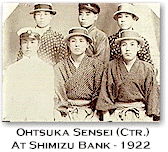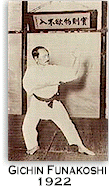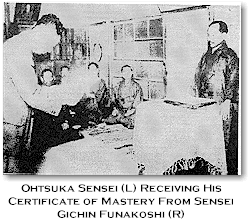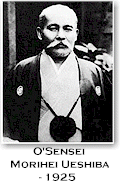Chapter
2  Water and Stone Water and Stone |
 |
In the Fall of 1922, Ohtsuka
Sensei found himself contemplating his future. In his family's eyes,
particularly his mother's, that future centered on guaranteeing their
son's  security. His studies at Waseda University had earned him an
associate degree in economics, and his position at the bank seemed
secure, along with his financial future. Such good fortune would leave
most young men at the age of 30 quite satisfied, indeed. But Ohtsuka
Sensei was anything but satisfied. He longed to become a professional
martial artist, devoting his life to the pursuit he loved. To his
parent's dismay, that pursuit was heightened as Ohtsuka read a newspaper
article one morning.
security. His studies at Waseda University had earned him an
associate degree in economics, and his position at the bank seemed
secure, along with his financial future. Such good fortune would leave
most young men at the age of 30 quite satisfied, indeed. But Ohtsuka
Sensei was anything but satisfied. He longed to become a professional
martial artist, devoting his life to the pursuit he loved. To his
parent's dismay, that pursuit was heightened as Ohtsuka read a newspaper
article one morning.
The story centered on Crown
Prince Hirohito's recent visit to Okinawa. The article said that while there,
Hirohito was entertained by a dancing performance and a demonstration of
tode or karate, which was at that time a little-known
Okinawan martial art. The news article also mentioned that a certain
Okinawan school teacher, Gichin Funakoshi had been
 invited by the Crown
Prince to travel to Tokyo to perform this local martial art before the
Emperor of Japan at a public hall in Tokyo. Ohtsuka Sensei immediately
made plans to attend. Impressed by what
he saw of Funakoshi's karate, Ohtsuka Sensei sought the
schoolteacher out following the performance, and introduced himself.
Equally impressed by this young man's spirit and knowledge of classical
Budo, Funakoshi invited Ohtsuka Sensei to train with him during his stay
in Tokyo.
invited by the Crown
Prince to travel to Tokyo to perform this local martial art before the
Emperor of Japan at a public hall in Tokyo. Ohtsuka Sensei immediately
made plans to attend. Impressed by what
he saw of Funakoshi's karate, Ohtsuka Sensei sought the
schoolteacher out following the performance, and introduced himself.
Equally impressed by this young man's spirit and knowledge of classical
Budo, Funakoshi invited Ohtsuka Sensei to train with him during his stay
in Tokyo.
As
a result of the immense popularity generated by Funakoshi's
demonstrations of karate, he elected to extend his stay in Japan indefinitely,
holding nightly classes at Tokyo's Meishojuko
Meeting Hall, which was quickly renamed the Meishojuko Dojo. Otsuka
trained virtually every night at the Dojo -- absorbing every move,
technique and nuance of this new art; and mastering it's simple, but
effective methods with astonishing speed. In the space of a year, he had
mastered all of the techniques and kata as taught by Funakoshi, and by
1924, had become his chief assistant instructor; an event that raised
more than a few eyebrows, particularly among Funakoshi's Okinawan
students. Nonetheless, his natural abilities could neither be ignored or
denied, and on April 24 of that year, Funakoshi-san named Hironori
Ohtsuka among seven men to receive the first Black Belts ever
presented in modern karate; ceremonially presenting each with a strip of
black cloth with their Certificate.
Nonetheless, his natural abilities could neither be ignored or
denied, and on April 24 of that year, Funakoshi-san named Hironori
Ohtsuka among seven men to receive the first Black Belts ever
presented in modern karate; ceremonially presenting each with a strip of
black cloth with their Certificate.
As
the relationship and bond strengthened between the two, Funakoshi
gradually began to rely more and more on Ohtsuka Sensei. Organization of
classes, demonstrations, and guidelines fell to his business discretion,
and instruction of advanced students became his exclusive
responsibility. By all appearances, his lifelong dream of becoming a
full-time martial artist had been realized. Indeed, reality had eclipsed
even his own early imagination. At the young age of 32, Hironori Ohtsuka
was already being counted among the hierarchy of contemporary Budoka.
The
other side of the reality, however, was that Ohtsuka Sensei was far from
satisfied with what he had attained. While Funakoshi's karate had
undeniably opened new vistas, he felt -instinctively- that something was
missing. Funakoshi's kata and the philosophies behind them had become
second nature to him; his understanding of them was obvious, and his ability
to convey those philosophies as an instructor, was evident. But
in his heart, as he continued to teach, he sensed there was
little or no common sense behind those philosophies -- no practical
application for self-defense. The movements were too rigid, too tense,
too...confined. And in point of fact, no avenue of testing those
philosophies was open; Funakoshi eschewed sparring of any kind at any
level of contact . Something was missing. And so, at the same time he was fulfilling
his new responsibilities to Funakoshi, Ohtsuka Sensei continued to
learn, absorb -- and expand his knowledge; privately seeking out
and training with other well-known sensei; including
Kenwa Mabuni - the founder of Shito Ryu - Choki Motobu, and most notably, the great
Morihei Ueshiba; founder and renowned spiritual Master of Aikido. It
was he who would help Ohtsuka discover the missing link in his dream,
and begin the quest to the awakening of Wado.
. Something was missing. And so, at the same time he was fulfilling
his new responsibilities to Funakoshi, Ohtsuka Sensei continued to
learn, absorb -- and expand his knowledge; privately seeking out
and training with other well-known sensei; including
Kenwa Mabuni - the founder of Shito Ryu - Choki Motobu, and most notably, the great
Morihei Ueshiba; founder and renowned spiritual Master of Aikido. It
was he who would help Ohtsuka discover the missing link in his dream,
and begin the quest to the awakening of Wado.
Like
Shindo Yoshin Ryu Jujutsu, Aikido was a direct descendant of the purest forms of classical
Aikijujutsu. With the exception of Shindo Yoshin Ryu's inclusion of
atemi (hand strikes and kicking techniques) Aikido's power lay in its reliance on the body's natural movements;
emphasizing breathing, relaxation, and the control of Ki -- the
natural energy that Buddhism taught flowed through all living things.
Where most forms of karate -specifically Okinawan karate- seemed to
emphasize generating an internal and external tension in the execution
of techniques, Ueshiba's philosophy of Aikido was completely the
opposite. He believed that the secret lay in blending with and redirecting an opponent's Ki -- flowing naturally with it -- not meeting it's force with
force.
For Ohtsuka
Sensei, it was as if he had awakened from one dream, only to begin
another; a dream that from the beginning, seemed crystalline in its
clarity and simplicity. A dream in which he envisioned blending the
basics of Funakoshi Sensei's karate with the natural movements, evasive
techniques and practicality of Shindo Yoshin Ryu together with the spiritual principles
of Aikido. It was a dream of a new Budo -- a new Way -- a Way of
Harmony -- ...like water flowing across stones.